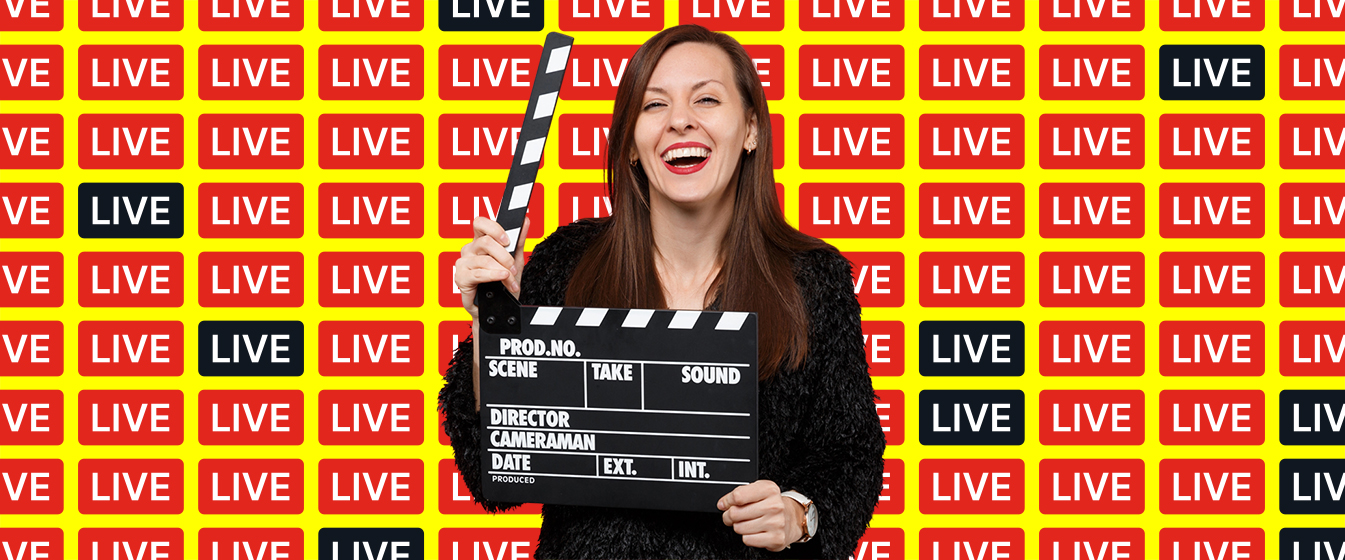Blog: Event management
6 event tech trends that will definitely play out in 2024 (maybe)
15 January 2024 minute read

Along with quitting drinking, joining a gym and trying in vain to get a store refund for some hideous polyester sweater without a receipt, lists of ‘event trends to look for in 20XX’ are one of the great traditions of early January.
So here are ours.
And before you ask, yes we do mention AI a couple of times. But most of the robot stuff is still more than a year away. And no, Mark, we’re not predicting that everyone will be wearing your Metaverse headsets by December either.
What we do see over the next 12 months are some big changes in how people use existing tech and platforms to inspire trust in their attendees and run impactful, profitable events in spite of a difficult economic outlook.
Oh, and we think there’s a chance Elon Musk might buy Cvent and call it something really crazy.*
Behaviour tracking via facial recognition
There’s nothing like a bit of Orwellian dystopia to get the new year underway.
We are not big fans of facial recognition technology here at AttendZen, but we do expect to see more investment flowing into China’s favourite tech trend from event tech players in 2024.
The case for using facial recognition as part of the check-in flow is sketchy at best. Unless your meeting has heightened levels of security, really what does it get you? Answers on a postcard please.
But the arguments for deploying smart cameras pointing at the audience in your auditorium, or scanning the exhibit hall, or individual booths, may be more persuasive (not to say pervasive).
There are already tech companies who will sell you equipment that purports to deliver ‘sentiment analysis’ on your attendees while they’re watching a presentation or just going about their business at your event.
Providers claim the tech can measure the happiness of attendees over time, promising valuable insights into which individuals and demographics are the most (and least) engaged with your content and networking offers. The idea is that you get more granular, candid feedback than you ever could from a survey – and you get it whether or not the attendee feels like giving it.
It can be deployed across in-person and virtual events, and while it’s still pretty new, we would be surprised if it didn’t get cheaper and more powerful in 2024 as more companies enter the market.
Whether sentiment analysis tracking will be tolerated by event audiences, or regulators, is another question – one which we explored in a blog post last year.
But expect to hear more about this stuff in 2024.
Hyper-personalisation
For some time, organisers have fixated on how to create the most individualised event experience for their attendees, and platforms like ours have helped them deliver this through smarter apps, marketing and data collection.
But we think 2024 will see the emphasis shift towards hyper-personalisation, which differs from good old-fashioned personalisation in its use of real-time data, AI and predictive analytics, as opposed to relying on historical attendee data to facilitate a totally tailored user experience.
What might this look like in practice? Well, by pitching content that is relevant and interesting to an individual attendee, organisers can capture their attention and encourage better participation. This can be achieved by offering things like breakout sessions, workshops, keynotes etc, in a dynamic way, based on real-time engagement with content in the attendee app, rather than using last year’s demographic data.
Expect to see more focus on personalised networking opportunities too – with matchmaking tools and algorithms to pair attendees with similar interests, and prompts to create networking opportunities that are more likely to result in valuable relationships.
We’ve long argued that better personalisation – both in marketing communications and in on-site experiences – is key to better events, but as AI muscles its way into the mix, we’d also strike a note of caution.
There is (we think) a risk of over-personalisation and with it, the potential to make your events feel intrusive or excessively tailored, giving the attendee a feeling of their privacy being invaded in some way, or the whole experience lacking in authenticity or even spontaneity.
Also, hyper-personalisation depends on precise and up-to-date customer data. Poor data quality will steer people toward some laughably bad attendee experiences and unfruitful personalisation initiatives.
Then there’s the potential for bias. Algorithms may unintentionally reinforce or even introduce prejudices, resulting in attendees receiving steers or recommendations that are unfair or discriminatory.
If the pandemic taught us anything, it’s that people prioritise human-centric experiences and connections. They want events to be real. So remember to take some the hype with a pinch of salt and don’t try to automate every last piece of the personalisation puzzle.

Generative AI goes from just writing stuff to doing stuff
If 2023 was the year when event planners tasked Chat GPT with writing marketing copy, composing agendas and drafting speaker invites (sometimes with hilarious consequences), 2024 might just be the year when they delegate the tedious business of negotiating with venues and suppliers.
The AI mega-trend for this year seems to be for developing Large Language Models into new ‘omniscient’ digital colleagues. Probably a bit more difficult than it sounds, but we’ll play along. Repetitive text or document-based tasks in particular are well suited to LLM agents. This raises the question as to whether they can be deployed to solicit and compare quotes and manage RFPs, evaluate suppliers, ‘read’ contracts, negotiate terms and even make bookings, all using parameters entered by you or simply learned from documents relating to the previous year’s event.
Think about it and it becomes obvious that an AI agent is pretty well equipped to handle tasks like spend analysis, risk controlling and contract management – potentially freeing up time your team could be spending on more creative, human-centric tasks.
There’s every chance that this year, somewhere in the world, an AI-enabled software instance belonging to an event planner will ‘call up’ another AI belonging to a venue or AV company and place a booking – all without the direct involvement of a human event manager.
Quite who you scream at if an AI hallucination causes it make the booking for the wrong day is less clear.
Data privacy
With consumers becoming increasingly conscious of their digital footprint, and governments world-wide tightening regulations, it’s a good idea for event organisers to have an eye on what lies ahead in the privacy space.
The event industry already has plenty of challenges around data privacy, ranging from siloed customer data in multiple apps, to major registration platforms who (quietly) own your attendees’ personal information and reserve the right to do what they want with it (including marketing competitor events and God knows what else).
But in 2024 we see three factors that will push data privacy even higher up your list of things to care about.
Heightened consumer awareness
The days of people blindly ticking the consent box on a web form are fading fast. As trust in tech companies declines, so public awareness of the intricacies surrounding data privacy and the value of their own PII increases. High-profile breaches and scandals in 2023 heightened consumer concerns, leading to a greater demand for transparency and control over digital information.
Generative AI and a stricter regulatory landscape
Governments around the world are drafting more stringent data protection laws, especially in view of AI.
Event tech companies are sitting on a treasure trove of customer data and they’re coming to realise that this data can be valuable to train artificial intelligence models – both their own, and (potentially) those of third-party clients or partners.
How would you feel about your event website content being used for that? What about your attendee lists and profiles? How about streaming video content of presentations? Direct messaging and one-to-one calls? Chat messages, attendee engagement data, polls, questions?
The end of third-party cookies
A pivotal shift in the digital marketing landscape comes with major browsers no longer supporting third-party cookies. This development will require marketers to pivot towards alternative methods of audience targeting and tracking.
This means exploring alternative first-party cookie and permission-based data strategies. Event owners will need to cultivate direct relationships with their attendees and rely on their own event website and app to gather information. Implementing strategies like permission-based data collection and creating personalised experiences will be crucial in maintaining audience engagement and understanding their preferences in the post third-party cookie world.

Decline of (some) social media
The social media boom of the last decade is over. It’s not that people are no longer using social media – they are. They’re just using it less and engaging differently.
This year, we expect the way business events use social media for marketing and audience engagement will shift significantly.
There’s already been a massive movement in favour of using LinkedIn over Facebook and X / Twitter – evidenced in the results of Convene’s latest Meetings Market Survey. LinkedIn was the most popular social media channel – used by three out of five organisers to promote their events. Just three years ago, Facebook was the leading channel for event promotion.
And what of the slow-motion car crash that is X / Twitter? Well, By September 2023, monthly active users had already dropped 15% worldwide (and 18% in the US) year-on-year, according to web analytics provider SimilarWeb. And the platform’s US, UK and European audiences are expected to shrink significantly over the next two years due to a mix of technical frustrations, the rise of hateful content, competition from other platforms and, frankly, people just not liking Elon Musk.
Critically, X / Twitter is no longer viewed as a safe space by major brands, which makes it a bad bet for marketing events (unless you’re organising NatCon, in which case relax: you’re exacty where you’re supposed to be!)
But the problems go way beyond Musk. Social media campaigns have become very expensive while the evidence of their effectiveness remains sketchy. So event owners will become choosier about which platforms to invest in.
A recent Hootsuite Social Trends 2024 report found that brands are concerned about the ROI they get from being on so many platforms, with more than half stating that the time or budget investment to maintain a presence on multiple social channels is an issue. More than a third said they’re worried about the accuracy of campaign metrics and the correlation between traction on social media and business outcomes.
Quelle surprise. Social media users want to socialise, network, be entertained and learn stuff, while social media platforms need to make people angry and waste their time in order to keep them online so advertisers can sell them stuff. The chickens of this misalignment between product and user-base are coming home to roost in greater numbers this year.
And once again, our old pal AI is part of the equation. Because if you can create content via AI – and 2024 is probably the year when we’ll see a plug-in for LinkedIn that will let you comment on and like posts and articles without actually doing it – then, frankly, why bother? How interested are you in reading comments made up by Chat GPT on articles also made up by Chat GPT?
If (when) this happens, even mighty LinkedIn’s growth spurt may sputter out, which, in turn, could lead to a resurgence of TikTok, YouTube and Instagram, because at least within these more visual spaces it’s easier to convey the feeling that there’s a real person behind the posts. At least for now.
We all have to do more (with less)
It feels like the do more with less philosophy is here to stay in events – and across business as a whole. To be honest, I don’t really like it as it suggests there’s a way to increase efficiency, productivity, and profitability ad infinitum without plugging in more resources, which is manifestly absurd.
In practice, ‘do more with less’ usually translates as ‘we don’t have money so why don’t we just expect our event managers to work even harder, faster, more efficiently and do the work of 2, 3, 4 … people’.
This, of course, is a recipe for burnout, leaving us feeling overworked, exhausted, undervalued and unappreciated.
However, there is always value in seeking to make our 8 (or 10) hours a day more productive. And the key to this is designing and embedding workflows that allow you to deliver more experiences which are both impactful and highly repeatable.
Every client we speak to, from the smallest team to the largest blue-chip corporate, is wasting effort somewhere with redundant tasks in their event delivery. Usually it’s manual data input, checking and transferring between multiple apps. Or re-inventing the wheel with agenda and session designs for each new event.
In 2024 we expect organisers to demand more from their technology partners in terms of streamlining and smart data integrations. Expect fewer disconnected ‘point’ solutions and a shift towards fully comprehensive platforms capable of handling registration, websites, marketing, virtual, apps and data – all in one unified stack.
You should expect your event technology to eliminate the busy work from your day and support you in establishing robust, documented processes that make sure all your best practice gets learned, shared and repeated across the team, while bad decisions get black-listed.
Of course, to do this you need partners with a deep understanding of how events work (not just software) and who are willing to spend time with your team, understanding your goals and culture, then adapt their tech to fit you like a handmade suit.
In truth, the key to success in today’s hyper-competitive event industry is not so much doing more with less, but rather doing better with what you have.
Of course we might be totally wrong about all of these trends, and if we are, then I promise to create a deep-fake video of me eating an AttendZen baseball hat this time next year.
But for now, we wish you the very best of luck with all your events in 2024, and if you need advice on your technology options, just give us a call.
*Just kidding!



